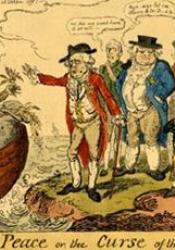1846 Repeal of the Corn Laws
COVE Timeline Assignment: 1846 Repeal of Corn Laws
The British Corn Laws, or laws that regulated imported grains and food, were influenced by both economic and political conditions in Britain. The purpose of the tariffs were to keep people from buying forgien corn products and, in turn, force people to buy domestic corn products. This was meant to stimulate Britain's economy by enforcing domestic industry practices; it was also enacted to heavily favor the rich landholders who were invested in farmland production. The Corn Laws would not allow foreign corn into Britain unless domestic corn reached a price of 80 shillings per quarter (Vamplew 3). These laws offered a “significant degree of protection to British cereal producers” (Vamplew 11) who made huge profits from grain production. Landowners, seizing the majority of monetary profit, also retained much of the political power at the time; the act of voting was reserved for those who owned land. Thus, the beneficiaries of the Corn Laws were not the common people who were forced to buy grain at an absurdly high price, but the few lucky enough reap the benefits.
While Britain's common people suffered from poverty, starvation and unsanitary living conditions, they were upset by the increasing price of grain products. Many had to quit their jobs because they were ill or they needed to take care of family members; those who did earn a wage used most of it to buy grain products to survive. The middle class was desperate for reform-- not wanting to suffer like those impacted by Irish in the Irish Potato Famine-- and wanted representation in their government. Cheryl Schonhardt-Bailey, author of From the Corn Laws to Free Trade: Interests, Ideas, and Institutions in Historical Perspective, writes “In sum, repeal was an attempt to moderate the mounting pressures for parliamentary reform: by satisfying the middle class industrialist with repeal, the drive to gain control of parliamentary seats would cease, and, moreover, the working class Chartist movement (seeking more radical reform of Parliament) would lose momentum” (16). The repeal of the Corn Laws was a motion intended to “settle down” the middle class by lowering the cost of grain products and thus progressing to a free market economy.
In addition to political reform, the repeal of the Corn Laws may have been the aftermath of a growing population; Betty Kemp, author of “Reflections on the Repeal of the Corn Laws” writes, “The simplest argument for the repeal of the Corn Laws is that the rapid growth of population' in the nineteenth century, which made it necessary to import increasing quantities of wheat, also made it un- justifiable to tax those imports” (3). Thus, a booming need for more materials lead to the repeal of the Corn Laws. This repeal, led by Sir Robert Peel, was a victory for the middle class (Kemp 2) and “the final triumph of the Free Trade move- ment” (Thomas 2) which sought to lower prices on grain and provided the economy with various trade options.
Supplemental Material
- Listen to this great song for a brief history on the repealing of the Corn Laws: Repeal of the Corn Laws Song
- Look at this political cartoon from UKParliment.org that illustrates the divided social classes:
Works Cited
Kemp, Betty. "Reflections on the Repeal of the Corn Laws." Victorian Studies 5.3 (1962):
189-204.
Schonhardt-Bailey, Cheryl. From the corn laws to free trade: interests, ideas, and institutions in
historical perspective. Mit Press, 2006.
Thomas, J. A. "The Repeal of the Corn Laws, 1846." Economica 25 (1929): 53-60.
Vamplew, Wray. "The protection of English cereal producers: the Corn Laws reassessed." The
Economic History Review 33.3 (1980): 382-395.

